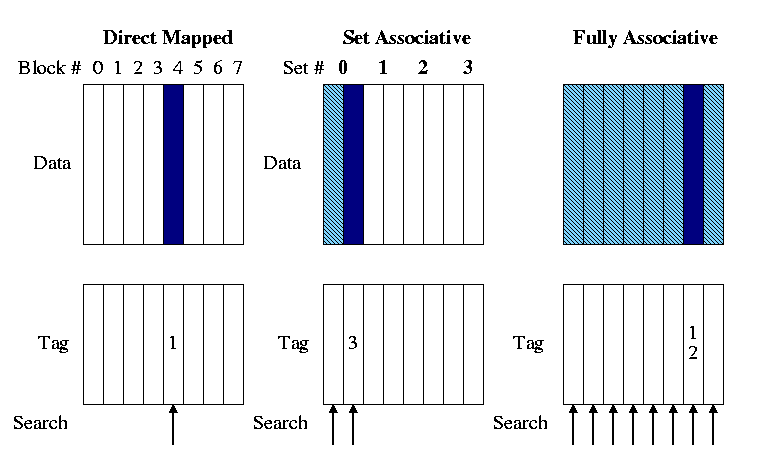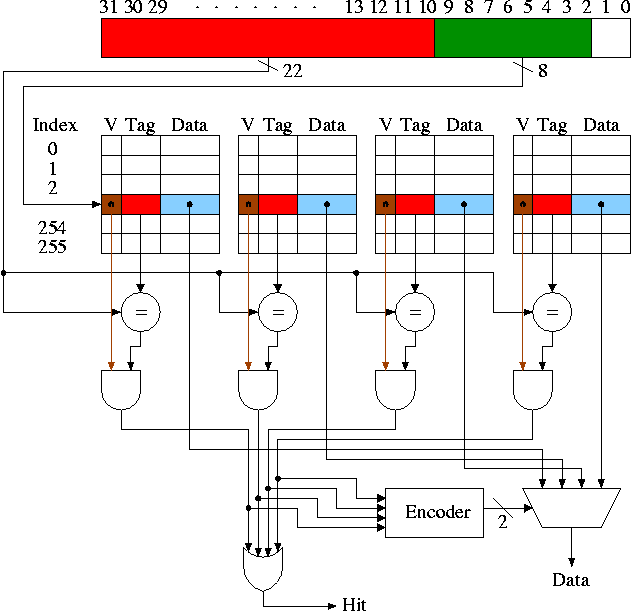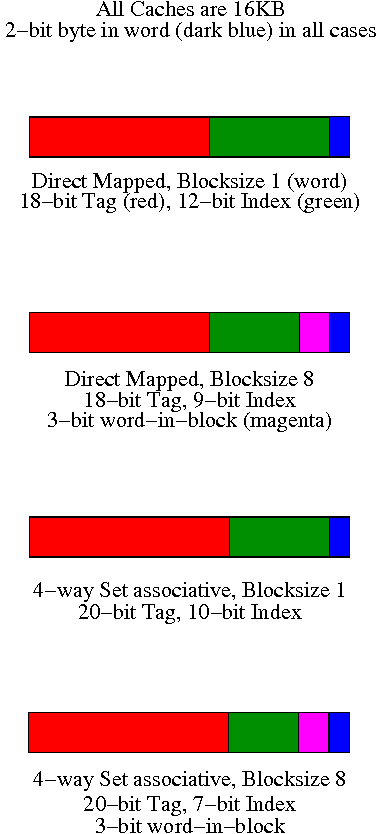Computer Architecture
Start Lecture #22
7.3: Measuring and Improving Cache Performance
Do the following performance example on the board.
It would be an appropriate final exam question.
- Assume
- 5% I-cache misses.
- 10% D-cache misses.
- 1/3 of the instructions access data.
- The CPI = 4 if the miss penalty is 0.
A 0 miss penalty is not realistic of course.
- What is the CPI if the miss penalty is 12?
- What is the CPI if we upgrade to a double speed cpu+cache, but keep a
single speed memory (i.e., a 24 clock miss penalty)?
- How much faster is the
double speed
machine?
It would be double speed if the miss penalty were 0 or if there
was a 0% miss rate.
Homework: 7.17, 7.18.
A lower base (i.e. miss-free) CPI makes stalls appear more expensive
since waiting a fixed amount of time for the memory
corresponds to losing more instructions if the CPI is lower.
A faster CPU (i.e., a faster clock) makes stalls appear more expensive
since waiting a fixed amount of time for the memory corresponds to
more cycles if the clock is faster (and hence more instructions since
the base CPI is the same).
Another performance example.
- Assume
- I-cache miss rate 3%.
- D-cache miss rate 5%.
- 40% of instructions reference data.
- miss penalty of 50 cycles.
- Base CPI is 2.
- What is the CPI including the misses?
- How much slower is the machine when misses are taken into account?
- Redo the above if the I-miss penalty is reduced to 10 (D-miss
still 50)
- With I-miss penalty back to 50, what is performance if CPU (and the
caches) are 100 times faster
Remark:
Larger caches have longer hit times.
Reducing Cache Misses by More Flexible Placement of Blocks
Improvement: Associative Caches
Consider the following sad story.
Jane has a cache that holds 1000 blocks and has a program that only
references 4 (memory) blocks, namely 23, 1023, 123023, and 7023.
In fact the references occur in order: 23, 1023, 123023, 7023, 23,
1023, 123023, 7023, 23, 1023, 123023, 7023, 23, 1023, 123023, 7023,
etc.
Referencing only 4 blocks and having room for 1000 in her cache,
Jane expected an extremely high hit rate for her program.
In fact, the hit rate was zero.
She was so sad, she gave up her job as webmistress, went to medical
school, and is now a brain surgeon at the mayo clinic in rochester
MN.
So far We have studied only direct mapped caches,
i.e. those for which the location in the cache is determined by the
address.
Since there is only one possible location in the cache for any
block, to check for a hit we compare one tag with
the HOBs of the addr.
The other extreme is fully associative.
- A memory block can be placed in any cache block.
- Since any memory block can be in any cache block, the cache
index where the memory block is stored tells us nothing about
which memory block is stored there.
Hence the tag must be the entire address.
Moreover, we don't know which cache block to check so we must
check all cache blocks to see if we have a hit.
- The larger tag is a problem.
- The search is a disaster.
- It could be done sequentially (one cache block at a time),
but this is much too slow.
- We could have a comparator with each tag
and mux all the blocks to select the one that matches.
- This is too big due to both the many comparators and
the humongous mux.
- However, it is exactly what is done when implementing
translation lookaside buffers (TLBs), which are used with
demand paging.
- Are the TLB designers magicians?
Ans: No.
TLBs are small.
- An alternative is to have a table with one entry per
memory block telling if the memory block is in
the cache and if so giving the cache block number.
This is too big and too slow for caches but is exactly what is
used for virtual memory (demand paging) where the memory blocks
here correspond to pages on disk and the table is called the
page table.
Set Associative Caches
Most common for caches is an intermediate configuration called
set associative or n-way associative (e.g., 4-way
associative).
The value of n is typically 2, 4, or 8.
If the cache has B blocks, we group them into B/n
sets each of size n.
Since an n-way associative cache has sets of size n blocks, it is
often called a set size n cache.
For example, you often hear of set size 4 caches.
In a set size n cache,
memory block number K is stored in set K mod the number of sets,
which equals K mod (B/n).

- In the picture on the right we are trying to store memory
block 12 in each of three caches.
- Figure 7.13 in the book, from which my figure was taken, has a
bug.
Figure 7.13 indicates that the tag for memory block 12 is 12 for
each associativity.
The figure to the right corrects this.
- The light blue represents cache blocks in which the memory
block might have been stored.
- The dark blue is the cache block in which the memory block
is stored.
- The arrows show the blocks (i.e., tags) that must be
searched to look for memory block 12. Naturally the arrows
point to the blue blocks.
The figure above shows a 2-way set associative cache.
Do the same example on the board for 4-way set associative.
Determining the Set Number and the Tag.
Recall that for the a direct-mapped cache, the cache index gives
the number of the block in the cache.
The for a set-associative cache, the cache index gives the number
of the set.
Just as the block number for a direct-mapped cache is the memory
block number mod the number of blocks in the cache, the set number
equals the (memory) block number mod the number of sets.
Just as the tag for a direct mapped cache is the memory block
number divided by the number of blocks, the tab for a
set-associative cache is the memory block number divided by the
number of sets.
Do NOT make the mistake of thinking that a set
size 2 cache has 2 sets, it has B/2 sets each of size 2.
Ask in class.
- What is another name for an 8-way associative cache having 8
blocks?
- What is another name for a 1-way set associative cache?
Why is set associativity good?
For example, why is 2-way set associativity better than direct
mapped?
- Consider referencing two arrays of size 50K that start at
location 1MB and 2MB.
- Both will contend for the same cache locations in a direct
mapped 128K cache but will fit together in any 128K n-way
associative cache with n>=2.

Locating a Block in the Cache
How do we find a memory block in a set associative cache with
block size 1 word?
- Divide the memory block number by the number of sets to get
the tag.
This portion of the address is shown in red in the diagram.
- Mod the memory block number by the number of sets to get the
tag.
This portion of the address is shown in green.
- Check all the tags in the set against the tag
of the memory block.
- If any tag matches, a hit has occurred and the
corresponding data entry contains the memory block.
- If no tag matches, a miss has occurred.
Recall that a 1-way associative cache is a direct mapped cache and
that an n-way associative cache for n the number of blocks in the
cache is a fully associative.
The advantage of increased associativity is normally an increased
hit ratio.
What are the disadvantages?
Answer: It is a slower and a little bigger due to the extra logic.
Choosing Which Block to Replace
When an existing block must be replaced, which victim should we
choose?
We ask the exact same question (with different words) when we study
demand paging (remember 202!).
- The victim must be in the same set as the new block.
With direct mapped (1-way associative) caches, this determined
the victim so the question didn't arise.
- With a fully associative cache all resident blocks are
candidate victims.
This is exactly the situation for demand paging (with global
replacement policies) and is also the case for
(fully-associative) TLBs.
- Random is sometimes used, i.e. choose a random block in the
set as the victim.
- This is never done for demand paging.
- For caches, however, the number of blocks in a set is
small, so the likely difference in quality between the best
and the worst is less.
- For caches, speed is crucial so we have no time for
calculations, even for misses.
-
LRU is better, but is not easy to do quickly.
- If the cache is 2-way set associative, each set is of size
two and it is easy to find the lru block quickly.
How?
Ans: For each set keep a bit indicating which block in the set
was just referenced and the lru block is the other one.
- If the cache is 4-way set associative, each set is of size
4.
Consider these 4 blocks as two groups of 2.
Use the trick above to find the group most recently used and
pick the other group.
Also use the trick within each group and chose the block in
the group not used last.
- Sound great.
We can do lru fast for any power of two using a binary tree.
- Wrong!
The above is not LRU it is just an approximation.
Show this on the board.
Sizes
There are two notions of size.
The cache size is the capacity of the cache.
This means, the size of all the blocks.
In the diagram above it is the size of the blue portion.
The size of the cache in the diagram is 256 * 4 * 4B = 4KB.
- Another size is is the total number of bits
in the cache, which includes tags and valid bits.
For the diagram this is computed as follows.
- The 32 address bits contain 8 bits of index and 2 bits
giving the byte offset.
- So the tag is 22 bits (more examples just below).
- Each block contains 1 valid bit, 22 tag bits and 32 data
bits, for a total of 55 bits.
- There are 1K blocks.
- So the total size is 55Kb (kilobits).
For the diagrammed cache, what fraction of the bits are user data?
Ans: 4KB / 55Kb = 32Kb / 55Kb = 32/55.
Tag Size and Division of the Address Bits
We continue to assume a byte addressed machines with all references
to a 4-byte word.
The 2 LOBs are not used (they specify the byte within the word, but
all our references are for a complete word).
We show these two bits in dark blue.
We continue to assume 32 bit addresses so there are 230
words in the address space.
Let's review various possible cache organizations and determine for
each how large is the tag and how the various address bits are used.
We will consider four configurations each a 16KB cache.
That is the size of the data portion of the cache
is 16KB = 4 kilowords = 212 words.

- Direct mapped, blocksize 1 (word).
- Since the blocksize is one word, there are
230 memory blocks and all the address bits
(except the blue 2 LOBs that specify the byte within
the word) are used for the memory block number.
Specifically 30 bits are so used.
- The cache has 212 words, which is
212 blocks.
- So the low order 12 bits of the memory block number give the
index in the cache (the cache block number), shown in green.
- The remaining 18 (30-12) bits are the tag, shown in red.
- Direct mapped, blocksize 8
- Three bits of the address give the word within the 8-word
block.
These are drawn in magenta.
- The remaining 27 HOBs of the
memory address give the memory block number.
- The cache has 212 words, which is
29 blocks.
- So the low order 9 bits of the memory block number gives the
index in the cache.
- The remaining 18 bits are the tag
- 4-way set associative, blocksize 1
- Blocksize is 1 so there are 230 memory blocks
and 30 bits are used for the memory block number.
- The cache has 212 blocks, which is
210 sets (each set has 4=22 blocks).
- So the low order 10 bits of the memory block number gives
the index in the cache.
- The remaining 20 bits are the tag.
- As the associativity grows, the tag gets bigger.
Why?
Ans: Growing associativity reduces the number of sets into
which a block can be placed.
This increases the number of memory blocks eligible to be
placed in a given set.
Hence more bits are needed to see if the desired block is
there.
- 4-way set associative, blocksize 8
- Three bits of the address give the word within the block.
- The remaining 27 HOBs of the
memory address give the memory block number.
- The cache has 212 words = 29
blocks = 27 sets.
- So the low order 7 bits of the memory block number gives
the index in the cache.
- The remaining 20 bits form the tag.
Homework: 7.46 and 7.47.
Note that 7.46 contains a typo !!
should be ||
.
Reducing the Miss Penalty Using Multilevel Caches
Improvement: Multilevel caches
Modern high end PCs and workstations all have at least two levels
of caches: A very fast, and hence not very big, first level (L1) cache
together with a larger but slower L2 cache.
When a miss occurs in L1, L2 is examined and only if a miss occurs
there is main memory referenced.
So the average miss penalty for an L1 miss is
(L2 hit rate)*(L2 time) + (L2 miss rate)*(L2 time + memory time)
We are assuming that L2 time is the same for an L2 hit or L2 miss
and that the main memory access doesn't begin until the L2 miss has
occurred.
Do the example on the board (a reasonably exam question, but a
little long since it has so many parts).
- Assume
- L1 I-cache miss rate 4%
- L1 D-cache miss rate 5%
- 40% of instructions reference data
- L2 miss rate 6%
- L2 time of 15ns
- Memory access time 100ns
- Base CPI of 2
- Clock rate 400MHz
- How many instructions per second does this machine execute?
- How many instructions per second would this machine execute if
the L2 cache were eliminated?
- How many instructions per second would this machine execute if
both caches were eliminated?
- How many instructions per second would this machine execute if
the L2 cache had a 0% miss rate (L1 as originally specified)?
- How many instructions per second would this machine execute if
both L1 caches had a 0% miss rate?



